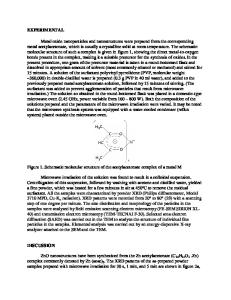Metal Oxide-Based Nanostructures
At present the use of metal oxide 1D nanomaterials such as nanobelts, nanowires, nanospheres, etc., is the most accepted approach in gas sensor design. Most designers believe that the use of single-crystal or polycrystalline nanowires (NWs) as gas sensors
- PDF / 1,349,175 Bytes
- 25 Pages / 504.57 x 720 pts Page_size
- 41 Downloads / 406 Views
Metal Oxide-Based Nanostructures
3.1
Metal Oxide One-Dimensional Nanomaterials
As research on carbon fullerenes and carbon nanotubes has shown, dimensionality is a very important factor in determining the properties of nanomaterials. Therefore, control of the size and shape of metal oxide crystallites is of great interest with regard to the application of such materials in gas sensors. To date, various kinds of 1D metal oxide structures have been synthesized as nanowires, nanotubes, nanospheres, nanorods, and nanobelts (Li et al. 2002; Jung et al. 2003; Varghese et al. 2003a, b; Kam et al. 2004; Guha et al. 2004; Kuchibhatla et al. 2007; Barth et al. 2010; Soldano et al. 2012) (see Fig. 3.1). Among the large numbers of MOX nanowires synthesized up to now, SnO2, In2O3, and ZnO nanowires are usually considered to be the best candidates for developing gas sensors (see Fig. 3.2) due to their relatively low cost of production and well-known properties (Mathur et al. 2007; Huang and Choi 2007; Barth et al. 2010; Choi and Jang 2010). It was found that, due to the progress achieved in the synthesis of 1D metal oxide nanomaterials, at present it is possible to synthesize high-quality nanomaterials with the length of individual nanowires up to 10–500 μm (Li et al. 2002; Zhang et al. 2004a). Interest in 1D ZnO structures is encouraged by the easy synthesis of high-quality and singlecrystalline 1D ZnO nanostructures. The synthesis of 1D nanostructures based on other sensitive metal oxides such as TiO2 and WO3 has been reported to be difficult compared to other oxides. Among many strategies to synthesize oxide NWs such as physical evaporation, silica-assisted Fe-catalytic growth, thermal reaction between powders and active carbon, alumina-assisted catalytic growth, and carbon-assisted synthesis, bottom-up growth is conventionally considered to be the most cost effective way to produce NWs in large quantities (Choi et al. 2008; Barth et al. 2010). These synthesis techniques, such as vapor–liquid–solid (VLS) or vapor–solid (VS) growth, yield randomly oriented assemblies of NWs. Most studies to date have been carried out on individual NWs selected from these assemblies and wired with appropriate contacts for transport measurements (see Fig. 3.3). This has been done largely because the measurement of individual NWs may allow study of the fundamentals of the gas-sensing effect in these MOX nanostructures (Kolmakov and Moskovits 2004).
3.1.1
1D Structures in Gas Sensors
It was established that over a wide range of operating temperatures, electronic properties of 1D structures are strongly influenced by surface processes (Kolmakov and Moskovits 2004; Vuong et al. 2012). It was found that, depending on the surrounding atmosphere in many cases, the NW resistance G. Korotcenkov, Handbook of Gas Sensor Materials, Integrated Analytical Systems, DOI 10.1007/978-1-4614-7388-6_3, © Springer Science+Business Media New York 2014
47
48
3
Metal Oxide-Based Nanostructures
Fig. 3.1 Morphology of as-made ZnO nanowires. (a–d) Long (10–15
Data Loading...









